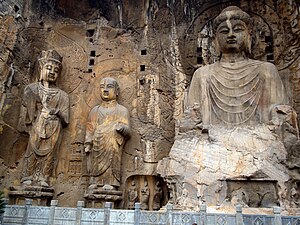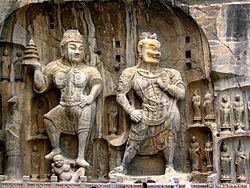Longmen Grottoes: Difference between revisions
m →History |
mNo edit summary |
||
| Line 57: | Line 57: | ||
==Visiting == |
==Visiting == |
||
{{commons|Longmen|Longmen Grottoes}} |
{{commons|Longmen|Longmen Grottoes}} |
||
The Longmen area is open to the public, and although the grottoes cannot be entered most of the artwork can be seen from the exterior. Standard tickets are 120 [[renminbi|RMB]]. Half price tickets (60 RMB) are available to Chinese students only. Foreign students may not use student cards to receive a discount. |
The Longmen area is open to the public, and although the grottoes cannot be entered, most of the artwork can be seen from the exterior. Standard tickets are 120 [[renminbi|RMB]]. Half price tickets (60 RMB) are available to Chinese students only. Foreign students may not use student cards to receive a discount. |
||
==Footnotes== |
==Footnotes== |
||
Revision as of 23:27, 30 March 2010
| UNESCO World Heritage Site | |
|---|---|
 | |
| Criteria | Cultural: i, ii, iii |
| Reference | 1003 |
| Inscription | 2000 (24th Session) |
The Longmen Grottoes (ch. 龍門石窟/ 龙门石窟, lóngmén shíkū; lit. Dragon's Gate Grottoes) or Longmen Caves are located 12 km south of present day Luòyáng in Hénán province, China. The grottoes, which overwhelmingly depict Buddhist subjects, are densely dotted along the two mountains: Xiangshan (to the east) and Longmenshan (to the west). The Yi River flows northward between them. For this reason, the area used to be called Yique (The Gate of the Yi River). From north to south, the distance covered by grottoes is about one km. Along with the Mogao Caves and Yungang Grottoes, the Longmen Grottoes are one of the three most famous ancient sculptural sites in China. There are over 2100 niches, more than 100,000 statues, some 40 pagodas and 3600 tablets and steles in the caves of Guyang, Binyang and Lianhua.
Statistics

According to the Longmen Caves Research Institute, there are 2345 caves and niches, 2800 inscriptions, 43 pagodas and over 100,000 Buddhist images at the site. 30% of the caves date from the Northern Wei Dynasty, 60% from the Tang Dynasty, and caves from other periods less than 10%. It is the most impressive collection of Chinese art from these dynasties, and, dating from 316 to 907 CE, represents the zenith of stone carving in China.[1]
History
During the Warring States Period, the general Bai Qi of Qin (state) once defeated the allied forces of Han (state) and Wei (state) at the site.
Construction of the grottoes themselves began in CE 493.
Most of the statues' heads had been destroyed during the Cultural revolution[2]
The area was inscribed on the UNESCO World Heritage List in November 2000. According to the inscription the Longmen Grottoes are an illustration of "the perfection of a long-established art form which was to play a highly significant role in the cultural evolution of this region of Asia."[1]
Individual grottoes by dynasty completed

Northern Wei
Sui
- South Binyang Cave (159)
Tang
- Fengxiansi
- 10,000 Buddha Cave
- Hidden Stream Temple Cave (20)
- Kanjingsi
- Dawanwufo Cave
- North Binyang Cave (104)
Visiting
The Longmen area is open to the public, and although the grottoes cannot be entered, most of the artwork can be seen from the exterior. Standard tickets are 120 RMB. Half price tickets (60 RMB) are available to Chinese students only. Foreign students may not use student cards to receive a discount.
Footnotes
- ^ a b "Longmen Grottoes". UNESCO. Retrieved 2007-09-06.
{{cite web}}: Cite has empty unknown parameter:|month=(help) - ^ [http://www.worldheritagesite.org/sites/longmengrottoes.html
External Links
- Transclusion error: {{En}} is only for use in File namespace. Use {{langx|en}} or {{in lang|en}} instead. Official Website of Longmen Grottoes

